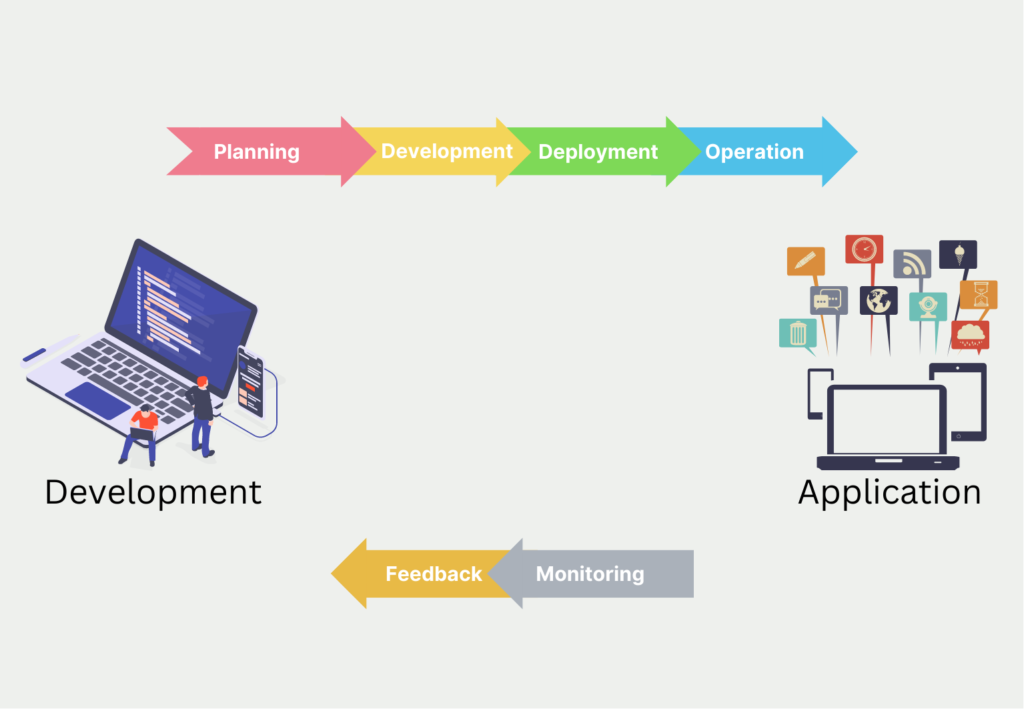The term DevOps covers the areas of development and operations in software development. It includes mindsets, practices, and technologies that are designed to help teams create services and software applications. This can be used, for example, to implement the further development of programs.
How does DevOps work?
The central point of DevOps involves the team working together from the creation of a prototype to the live launch of the finished application and far beyond. For this purpose, various team roles are defined to ensure a smooth and fast process.
This approach differs from previous practices in that the development team and the operations team now work closely together. Previously, applications were created by developers and once they went live, they were handed off to the operations team, which was tasked with ensuring the accessibility and performance of the service. However, as a result, valuable information is lost between the two teams, such as improvement suggestions from the operations team.
Depending on the application, experts from security or quality assurance can also be brought into the project team in addition to these departments. Especially if aspects from these areas are of particular importance for the project.
The team uses practices originally known as process automation that can also be applied to software development. The focus is on an endless loop of processes that are run through step by step.
What is the DevOps lifecycle?
The DevOps lifecycle describes the central process within software development. The individual stages are run through once in a project and can continue to be used after completion to improve the application throughout.
Depending on the source, the naming of the stages may differ, but the same process is always described:
- Planning: Before software development can begin, the new application must be planned. This includes tasks such as defining requirements, the composition of the project team, or the schedule up to going live. In this phase, concepts of agile software development are primarily used, such as Kanban boards or Scrum.
- Development: In this phase, the individual parts of the application are programmed, tested, and checked. Functionality testing takes place in various stages that increasingly approach the productive environment. In these, new functionalities can be tested intensively without affecting the production environment.
- Deployment: During deployment, the finished application is made available to end users in a productive environment. This includes the integration of a powerful infrastructure that can handle the expected loads.
- Operation: Shortly after the application has been transferred to a productive system, the operation phase begins, in which the flawless functionality of the program is ensured on a sustained basis. This includes, for example, checking logs during troubleshooting or, if necessary, adapting the infrastructure if the system’s performance needs to be increased.
- Monitoring: In this phase, it is observed how the end users interact with the software and whether it fulfills the requirements from the planning phase or not.
- Feedback: The results of the monitoring phase are now evaluated and it is decided whether an improvement of the application is necessary. Then the lifecycle starts again with the planning phase.

What are the Benefits of using DevOps?
In most cases, moving to the DevOps lifecycle can lead to the following benefits:
- Speed: Thanks to process optimization, new developments can reach a high degree of maturity much more quickly, while at the same time incorporating feedback from customers and a changing market environment. This speed also explicitly relates to deployment. A fast deployment helps to react to bugs in a short time and to keep customer satisfaction high.
- Team Morale: The active collaboration of different teams significantly improves morale among each other. At the same time, it can also be motivating if the operations team has an important influence on the adaptation and further development of the application. Otherwise, in an organization without DevOps, resentment can easily arise if there is a feeling that software development is programming applications that are not easy to manage.
- High Quality: Due to the intensive testing cycles in the various environments, new developments are tested under realistic circumstances and their functionality is ensured. As a result, only high-quality innovations make it into the productive system and only lead to errors in rare cases. This increases the overall quality of the system.
Which Tools can be used for DevOps?
A number of tools have already established themselves on the market to support companies in implementing DevOps in software development. The following order has no significance for the quality of the tools and is merely alphabetical.
Asana
Asana is an organizational tool that enables teams to organize their work in projects quickly and easily. It is not specifically limited to work in the DevOps area, but can also be used for projects outside of software development. Asana is offered as a Software-as-a-Service (Saas) and can therefore be called up via the web browser.
Atlassian
Atlassian is not a program per se, but a vendor that provides many tools that can be used for almost all phases of the DevOps lifecycle. These include, for example, the programs Jira for project management, Bit Bucket for managing the programming code, or Bamboo for testing the code in the various development environments.
Git
The GitHub portal is already known to many in the Machine Learning field as a platform for sharing programming code. However, it can also be used within companies to enable team collaboration and to share and organize different states of code. For example, functions such as access control can then be set up to ensure that only selected people can modify the code.
Selenium
With the help of Selenium, automated test programs can be implemented that run a certain usage sequence and can thus imitate a human user. The tool is open-source and can be used for load tests, for example. It simulates the simultaneous use of many users and tests how the program behaves in order to detect possible bottlenecks.
What is MLOps?
MLOps, or Machine Learning Operations, is an emerging field that combines the principles of DevOps with machine learning to manage and streamline the Machine Learning lifecycle. It aims to automate the processes involved in building, deploying, and managing machine learning models in production.
As Machine Learning models become more complex and are applied to more critical use cases, the need for effective management and monitoring of these models in production has become increasingly important. This is where MLOps comes in, as it helps to streamline the machine learning lifecycle and ensure that models are deployed and managed effectively in production.
The concept involves a number of key processes, including:
- Data Management: MLOps involves managing large volumes of data and ensuring that the data is clean, accurate, and representative of the real-world scenarios that the model will encounter in production.
- Model Training: Once the data has been collected and preprocessed, it involves training the model using a variety of techniques, such as supervised, unsupervised, or reinforcement learning.
- Model Deployment: After the model has been trained, MLOps involves deploying the model to a production environment where it can be used to make predictions or perform other tasks.
- Model Monitoring: Once the model is in production, MLOps involves monitoring the model to ensure that it is performing as expected and identifying any issues that may arise.
- Model Retraining: MLOps also involves retraining the model periodically to ensure that it remains accurate and up-to-date with any changes in the data or the environment.
What are the differences between MLOps and DevOps?
DevOps and MLOps are related but have different practices in the field of software development and operations. Here are the differences between DevOps and MLOps:
- DevOps is a set of practices that emphasize collaboration and communication between development and operations teams, with the goal of improving the speed and quality of software delivery. In contrast, MLOps is a set of practices that focus specifically on the deployment and management of machine learning models.
- DevOps is concerned with the entire software development lifecycle, from planning and coding to testing, deployment, and monitoring. MLOps, on the other hand, is focused on the latter stages of the lifecycle, particularly the deployment and management of machine learning models in production environments.
- DevOps aims to improve the speed, reliability, and quality of software delivery by automating manual processes, reducing the risk of errors, and enabling faster feedback loops. MLOps, on the other hand, focuses on ensuring that machine learning models are deployed in a scalable and reliable manner and that they continue to perform effectively over time.
- While DevOps emphasizes the use of tools and technologies such as continuous integration/continuous delivery (CI/CD) pipelines, containerization, and configuration management, MLOps requires additional tools and technologies specific to machine learning, such as model versioning, model monitoring, and data lineage tracking.
In summary, while both DevOps and MLOps share some similarities in terms of their focus on automation, collaboration, and continuous improvement, they are distinct practices with different goals, tools, and requirements.
This is what you should take with you
- The term DevOps covers the areas of development and operations in software development.
- When new applications are developed, a project team is put together for this purpose from employees from development and operations.
- The main concept of DevOps is the so-called life cycle, which, depending on the literature, consists of the phases of planning, development, deployment, operation, monitoring, and feedback.
- With the help of DevOps, new projects can be implemented much faster and it is possible to react more quickly to bugs and changes in the market.
What is Collaborative Filtering?
Unlock personalized recommendations with collaborative filtering. Discover how this powerful technique enhances user experiences. Learn more!
What is Quantum Computing?
Dive into the quantum revolution with our article of quantum computing. Uncover the future of computation and its transformative potential.
What is Anomaly Detection?
Discover effective anomaly detection techniques in data analysis. Detect outliers and unusual patterns for improved insights. Learn more now!
What is the T5-Model?
Unlocking Text Generation: Discover the Power of T5 Model for Advanced NLP Tasks - Learn Implementation and Benefits.
What is MLOps?
Discover the world of MLOps and learn how it revolutionizes machine learning deployments. Explore key concepts and best practices.
Other Articles on the Topic of DevOps
Dies sind interessante Beiträge zum Thema DevOps, die teilweise auch als Referenzen genutzt wurden:

Niklas Lang
I have been working as a machine learning engineer and software developer since 2020 and am passionate about the world of data, algorithms and software development. In addition to my work in the field, I teach at several German universities, including the IU International University of Applied Sciences and the Baden-Württemberg Cooperative State University, in the fields of data science, mathematics and business analytics.
My goal is to present complex topics such as statistics and machine learning in a way that makes them not only understandable, but also exciting and tangible. I combine practical experience from industry with sound theoretical foundations to prepare my students in the best possible way for the challenges of the data world.





